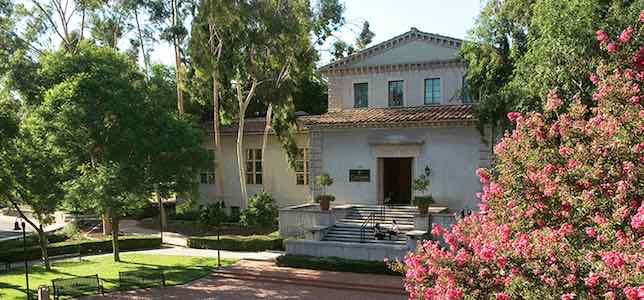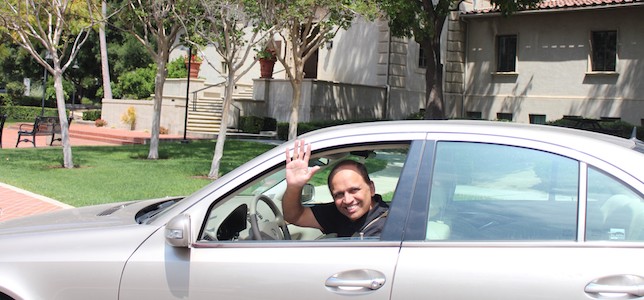Remaining High-Touch for Graduate Students in a Contactless Pandemic
A Q&A with Manoj Chitre
Claremont Graduate University, located in Claremont, California, is a member of the Claremont Colleges consortium of seven institutions that are administratively separate but academically intertwined. CGU is among just a few graduate-only institutions in the US, and it prides itself on a high-touch environment for students, based on exceptional access to faculty.
As CGU's associate vice president for technology services and information systems, Manoj Chitre is an important part of the administrative team responsible for maintaining the institution's high-access connections between faculty and students. We asked him about CGU's experiences in responding to the challenges most higher education campuses have faced this past year or so, when the COVID-19 pandemic necessitated the sudden transformation of many administrative and academic functions to remote processes.

Harper Hall, Claremont Graduate University's main administrative building
Mary Grush: Especially considering CGU's commitment to a high-contact experience for its students, what challenges did the pandemic bring to the Office of IT and how did it respond?
Manoj Chitre: Prior to the pandemic, with predominantly an in-person teaching, learning, and administration focus, there was not much pressure to handle academic or administrative processes at a distance. Students were always on campus.
And while we were definitely moving in the direction of digitizing many of our processes and enabling virtual, student-centric services, such plans became urgent priorities when the pandemic forced us to move the university off campus.
But we moved with the agility of a technology startup! That was challenging, but it has also been rewarding, particularly now, looking back one year after that forced transition.
Grush: How did you focus the department's efforts as you faced this urgent transition? Were there certain technology areas or objectives in which you placed a lot of your concentration, especially initially?
Chitre: Our pandemic transition was geared toward continuity: academic continuity in teaching and learning; operational continuity; and research/scholarship continuity.
From an instructional perspective, our Canvas LMS adoption exploded — especially with the use of course design templates that standardized asynchronous course content. We immediately signed up for premium 24/7 Canvas support to assist faculty and students working in various time zones.
Zoom platform use also expanded exponentially, from two relatively modest programs, to virtually all our programs for synchronous teaching and learning. In addition to short-term class recordings in Zoom, we adopted Kaltura video management to allow students to access lectures and webinars, complete with captioning, for longer durations.
Grush: How did you support such seemingly vast changes, especially at first, while upholding your focus on continuity and mapping it to those three areas (the academic, operational, and research/scholarship)?
Chitre: Our pivot to remote teaching began by providing technology training for faculty, to help them succeed in their use of the core tools I mentioned earlier. Our initial training included workshops on technology and pedagogy offered by CGU's offices of IT, Online Programs, and Preparing Future Faculty, as well as by a consortium resource called the Center for Teaching and Learning.
For learning continuity, we made Technology on Loan, a remote classroom/lab solution, available to students. That provided computing capacity along with university-provided software tools such as SPSS, SAS, ArcGIS, and others.
For business and administrative continuity, we ramped up our existing business process initiatives: airSlate's workflow automation solutions including their signNow digital e-signature product; timekeeping/payroll business processes in Workday/Kronos; and Microsoft 365 expansion beyond mere e-mail — in which we included Teams, OneDrive, Bookings, and Stream.
For our research and scholarship continuity, we provided special and individualized resources and guidance to those who would continue their research activities remotely.
Grush: Beyond those key areas of continuity, did the Office of IT work on any resources or services directly related to campus COVID-19 management?
Chitre: Oh, of course! The university established a COVID-19 task force comprised of key university departments (including OIT), and that continues to meet multiple times a week in order to steer the university through ever-changing guidelines and protocols from state and county public health authorities. The task force employs technology to ensure health and safety in the areas of COVID-19 testing, screening, contact tracing, vaccinations, and emergency response systems.
Grush: Everything you've outlined so far seems to add up to a huge effort, with not a lot of lead time. Did you find any particular resources in the higher education community that were available to help?
Chitre: As always, the higher education community has been very resourceful and collaborative. Of course, there have been some resources we've relied on most heavily in the past year.
As always, the higher education community has been very resourceful and collaborative.
First of all are the extraordinary benefits that are always available to us by virtue of our membership in the Claremont consortium, for knowledge sharing among our peers and member institutions. And as a CIO, I value my affiliation with the SoCal Higher Ed CIO alliance. Of course, Educause resources, surveys, and lists always provide current and valuable insights. And finally, Internet2 has a wealth of resources for cloud solutions along with relevant practical tools. Some of the tools from I2 have long been a part of our strategies, including InCommon federated identities for eduroam. Such tools have become increasingly relevant: For example, I2 members can now get airSlate e-signature and document management solutions via I2 Net+ as I2 continues to expand its Net+ offerings.
All the resources and tools I've mentioned here are just a sampling of the benefits that we receive from the higher education communities we "tie into" on a regular basis. But we appreciate them all the more in a crisis.
Grush: Did any of the steps you took during the pandemic or earlier prove to be particularly helpful — now that you can look back a year or more in the context of your pandemic response?
Chitre: Sure. In late 2019, our academic computing committee, comprised of faculty, staff, and student representation, prioritized digitization of several manual and paper-intensive business processes that impacted our student service orientation. They also analyzed the need to enable digital signatures on contract documents.
We evaluated a number of well-established products and some emerging ones, including signNow. Through that committee's efforts, we came to know airSlate, a fairly new offering for a range of business process automation solutions — not limited to e-signatures. As an outcome of our research, we became early adopters of airSlate in higher education. Just as we began to plan implementation, the pandemic hit. The timing could not have been better.
The signNow and other airSlate implementations have supported CGU immensely in our unplanned pivot to a remote teaching, learning, and working environment. While we had planned to implement airSlate for various student workflows, our first workflow project ended up being flows to manage COVID-19 related processes — including campus visit procedures, health screenings, building checkins, and so forth. We have recently added a vaccination confirmation and proof upload workflow using airSlate. The airSlate implementation team, led by Eric Werner, has simultaneously been rolling out workflows for our 2100-plus students to minimize manual paperwork while still setting students up for success. With airSlate, we have facilitated several dozen student forms — including commencement registration, program-related petitions, enrollment verifications, and leave of absence requests, to name just a few.
We plan to continue to streamline manual paper processes using technology tools such as signNow and airSlate document management. And the work we have done on campus in response to pandemic issues has earned a lot of recognition on our campus and throughout the consortium: Nowadays, whenever I am in meetings with various university offices, in discussions about current challenges and process improvements, people often first ask about airSlate as a potential solution.
Grush: Specific to CGU, what teams or staff on campus had the most responsibility to implement strategies, where changes had to be made quickly, and what were the impacts on them?
Chitre: Of course there isn't space here to call out everyone by name, but I will say that first and foremost was the leadership of our Provost Patricia Easton, who helped steer the campus through what has been one of the most challenging times in CGU's 95-plus years. And the support and encouragement from President Len Jessup and financial support by our Treasurer, Leslie Negritto, were invaluable in helping implement strategies.
Then, it may seem obvious, but our faculty carried the biggest burden in transforming their teaching from the existing, traditional modality to a completely remote style — with little pedagogical history behind them in delivering their quality education virtually. But our CGU faculty adapted quite well — just as, we're aware, dedicated faculty at other institutions, all over the US were stepping up to the needed changes as the pandemic progressed.
Our faculty carried the biggest burden in transforming their teaching from the existing, traditional modality to a completely remote style.
From a staff standpoint, every office from Recruitment, to Admissions, to Student Services had to turn on a dime to provide continuity.
But by far, the Office of Information Technology bore the brunt of the responsibility. Our small but mighty IT team (specifically the Academic Technology and Client Services groups led by Michael Thomas) worked tirelessly as essential workers to ensure continuity of university's mission, especially in the first 4 months of the pandemic. Information security — identity management, duo multi-factor authentication, Azure SSO, and managing and securing hundreds of distributed computing end points have been some of the critical areas IT teams have successfully tackled. Our Network team implemented campus-wide outdoor wireless/wifi on an emergency basis to enable students to have Internet connectivity outdoors, now and when we return to campus.
Academic program and Student Services offices such as the Center for Writing and Rhetoric, as well as Preparing Future Faculty, support faculty development at CGU by providing new faculty orientation workshops as well as general workshops and resources to continually improve the student experience and faculty effectiveness. The offices of Student Engagement, Life, and Career Services operate quite effectively in a remote mode, providing all their services virtually.
Grush: Could you point to one thing learned or cite one memorable moment you'll always keep in mind when you think back on this past year?
Chitre: I'll do both. A key learning takeaway comes from observing how CGU has moved with the agility of a tech startup and adapted to virtual modality without compromising its mission of education connectedness. We now know that some elements of remote work are here to stay, and as long as this is managed carefully, productivity and morale gains can be enormous.

Manoj Chitre greets colleagues with a wave
My most compelling memories — images I'll never forget — are of our Winter staff drive-by gathering this past December. People who worked together virtually all year were finally able to see each other, even if it was just a quick wave from the driver's seat of their car. These simple but powerful interactions showed us, again, the human need to connect with each other. Going forward, we'll use all our technology to serve this value.
[Editor's note: Images courtesy Claremont Graduate University.]
About the Author
Mary Grush is Editor and Conference Program Director, Campus Technology.